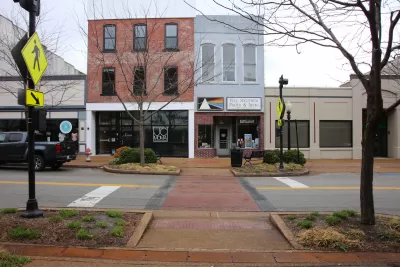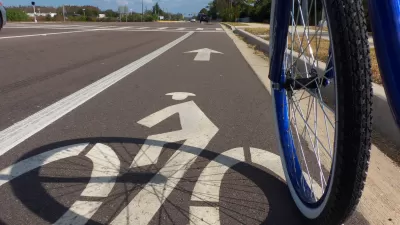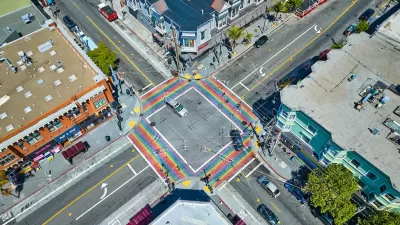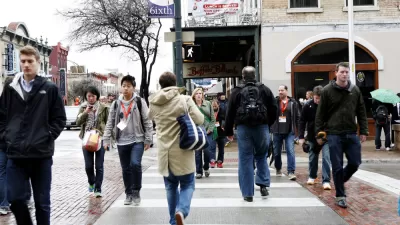In Philadelphia, letting pedestrians cross at more places helps challenge the norms that privilege cars.

Inga Saffron writes about mid-block crosswalks in Philadelphia, a strategy that helps prioritize pedestrians by giving them more locations to cross streets. Corner crosswalks are designed around vehicle traffic, while mid-block crosswalks better reflect how and where people want to use streets.
So far, many of these crosswalks in Philadelphia have been private projects. Comcast is behind one of the best, says Saffron — a mid-block crosswalk connecting two towers that many employees move between:
Flashing lights attached to poles alert motorists to slow down as they approach the unusual crossing. The street on both sides of the walkway also has been paved with rough granite blocks, another traffic-calming measure. Instead of simply painting black-and-white stripes in the street, Comcast installed bricks treated with a glazed, reflective coating in those colors.
The city says the budget for such street improvements is limited, and justifying the investment in the crosswalks in Philadelphia neighborhoods has been hard. Still, transit advocates say that they are needed at locations throughout the city where crossing is dangerous or pedestrians have limited options.
"It’s always been human nature to seek out the shortest path between Point A and Point B. If Philadelphia is going to be the walkable city we claim it is, then we have an obligation to make it safe, no matter where people insist on crossing the street," argues Saffron.
FULL STORY: Go ahead, cross in the middle of the block

Trump Administration Could Effectively End Housing Voucher Program
Federal officials are eyeing major cuts to the Section 8 program that helps millions of low-income households pay rent.

Planetizen Federal Action Tracker
A weekly monitor of how Trump’s orders and actions are impacting planners and planning in America.

Ken Jennings Launches Transit Web Series
The Jeopardy champ wants you to ride public transit.

Crime Continues to Drop on Philly, San Francisco Transit Systems
SEPTA and BART both saw significant declines in violent crime in the first quarter of 2025.

How South LA Green Spaces Power Community Health and Hope
Green spaces like South L.A. Wetlands Park are helping South Los Angeles residents promote healthy lifestyles, build community, and advocate for improvements that reflect local needs in historically underserved neighborhoods.

Sacramento Plans ‘Quick-Build’ Road Safety Projects
The city wants to accelerate small-scale safety improvements that use low-cost equipment to make an impact at dangerous intersections.
Urban Design for Planners 1: Software Tools
This six-course series explores essential urban design concepts using open source software and equips planners with the tools they need to participate fully in the urban design process.
Planning for Universal Design
Learn the tools for implementing Universal Design in planning regulations.
Heyer Gruel & Associates PA
Ada County Highway District
Institute for Housing and Urban Development Studies (IHS)
City of Grandview
Harvard GSD Executive Education
Toledo-Lucas County Plan Commissions
Salt Lake City
NYU Wagner Graduate School of Public Service





























